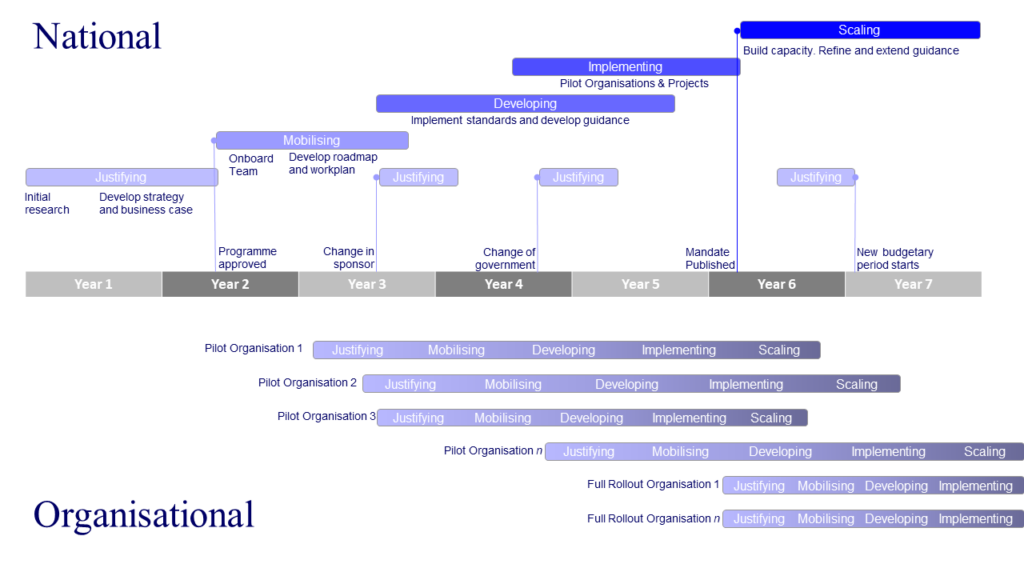States Overview
Summary
There are five states of digital transformation which are defined and used in this playbook. The five states help to explain the stages through which a digital transformation programme will transition to achieve its outcomes. Each of these states forms a section of the playbook which can be reviewed sequentially or in isolation to provide thoughts and guidance to help the current situation. The five states are defined as:
- JUSTIFYING the change and gaining stakeholder support.
- MOBILISING your transformation programme to accelerate change.
- DEVELOPING the legal, commercial and technical framework.
- IMPLEMENTING the change in practice onto projects.
- SCALING the change and communicating progress.
The states form a pathway from a starting point of understanding the reasons for initiating a digital transformation programme, through JUSTIFYING, MOBILISING, DEVELOPING, IMPLEMENTING, and finishing at SCALING where the change transitions into business as usual to achieve its outcomes.
Having mentioned that these 5 states form a pathway for the transformation, it’s also worth highlighting that these states do not always form a linear process. Some programmes may start at a later stage of development, and the approach to each state may vary. It may be necessary to revisit states more than once for various reasons. For example, it may be necessary to revisit the justifying state at several points throughout the programme, or it may be necessary to revisit developing as the industries capability and capacity for digital increases. As the programme progresses, there is unlikely to be a clear line between the transformation states. The programme will likely be working in multiple states at once, for example continuing the developing work while also implementing the change to projects.
Like a construction project which goes through multiple stages, from concept through to construction and operation, the states of transformation start with a relatively low level of involvement from a small group of people and then this will expand through the various stages. As the programme moves through each stage, the amount of involvement, people and resources are likely to increase.
Definitions for each state
JUSTIFYING
In the justifying state, the programme will identify and rationalise the need for change, as well as its existence. This is typically the first stage of the transformation journey. It involves raising awareness of the need for change and its benefits, influencing stakeholders to achieve buy-in to the programme, and building a coalition to support the change. A business case is developed to understand programme costs, anticipated returns on investment, resource requirements and removal of programme obstacles to achieve change.
MOBILISING
The mobilising state includes beginning to action the business case and developing a roadmap for change. A key component of this state is the establishment and mobilisation of a programme team to achieve the change outlined in the business case. The mobilised programme team will then start to build a framework of consistent principles to accelerate change. Some of the key programme documents and outputs of this state are contained within a strategy document.
DEVELOPING
This state involves the development of a collaborative framework of standards and guidance which defines the requirements for a standardised approach to digital transformation. Engagement and two-way communication between the programme team, key stakeholders and industry is essential for the production of a collaborative framework that incorporates existing best practice and international standards.
IMPLEMENTING
With the collaborative framework for change defined, this state focuses on the implementation of digital ways of working with pilot projects. This demonstrates the benefits of the practical application of digital transformation and allows for the benefits to be measured.
SCALING
This stage is focussed on reaching the wide range of the industry to include and support everyone impacted by the change. Communication across the construction industry is key to achieving awareness, receive feedback on the adoption of change and maximise the impact of the transformation programme.
Use of the states in practice
The five transformation states describe most of the work involved in a digital transformation programme from initiation to completion. However, it is recognised that additional activities may be completed prior to initiating the programme and subsequently, following its completion. Before establishing a digital transformation programme, it is important to have a background understanding of the subject and a rational for digital transformation. Typically, there is an element of pre-work to assess the need for digital transformation and the benefits it can deliver at the national and organisational level will be completed prior to entering the justifying state. Upon entering the justifying state, it is assumed there will be a limited understanding of digital, but there will be an awareness of some of the benefits it can deliver. An objective of early state work will be to rationalise and evidence that digital transformation is the correct approach to the identified national or organisational challenge(s).
Similarly, continuous improvements are likely following the completion of the scaling state of transformation. Once the change has been successfully implemented and scaled to meet the goals and vision of the programme there is usually additional scope for continuous development. After the transformation programme has been completed there are likely to be new opportunities for delivering value and savings from digital by optimising the application of digital to further enhance benefits. Once the transformation has become business as usual, the programme should focus on refinements and optimisation to constantly improve the baseline moving forwards.

